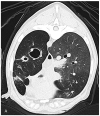Sub-Antimicrobial Dosage Scheme of Doxycycline for the Chronic Treatment of Bronchiectasis in a Dog
- PMID: 35324864
- PMCID: PMC8954054
- DOI: 10.3390/vetsci9030137
Sub-Antimicrobial Dosage Scheme of Doxycycline for the Chronic Treatment of Bronchiectasis in a Dog
Abstract
A 9-month-old German shepherd dog was examined because of a chronic cough, exercise intolerance and labored breathing, as well as recurrent episodes of lethargy with anorexia. Multifocal severe bronchiectasis and neutrophilic bronchitis was found with thoracic computed tomography and cytology of bronchoalveolar lavage fluid, respectively. While oral azithromycin was administered, clinical signs were absent. However, stopping azithromycin lead repeatedly to presumed bacterial pneumonia within 1-2 months. With sub-antimicrobial dosed oral doxycycline (initially 1.5 mg/kg once daily for 3 months, then 0.7-0.5 mg/kg once daily for 6 months), the dog remained free from clinical signs. Bronchiectasis is characterized by marked irreversible bronchial dilation. Accumulation of intraluminal mucopurulent material and neutrophilic inflammation cause chronic cough and recurrent bacterial pneumonia. For therapy, life-long oral antibiotics are recommended. Chronic antibiotic administration, however, can select resistant bacterial strains. Though both azithromycin and doxycycline possess anti-inflammatory effects, doxycycline has these off-target properties at a sub-antimicrobial dose. In this report, a chronic sub-antimicrobial dose of doxycycline resulted in the resolution of chronic cough, exercise intolerance and labored breathing, and prevented recurrence of suspected bacterial pneumonia in the long-term in a dog with severe bronchiectasis. Beneficial effect of doxycycline is probably related to its anti-inflammatory effects rather than its antimicrobial properties.
Keywords: antibiotics; bacterial pneumonia; matrix metalloproteinase; prevention.
Conflict of interest statement
The authors declare no conflict of interest.
Figures


Similar articles
-
Recurrent, protracted and persistent lower respiratory tract infection: A neglected clinical entity.J Infect. 2015 Jun;71 Suppl 1:S106-11. doi: 10.1016/j.jinf.2015.04.011. Epub 2015 Apr 25. J Infect. 2015. PMID: 25917807 Review.
-
Paediatric chronic suppurative lung disease: clinical characteristics and outcomes.Eur J Pediatr. 2016 Aug;175(8):1077-84. doi: 10.1007/s00431-016-2743-5. Epub 2016 Jun 11. Eur J Pediatr. 2016. PMID: 27287408
-
Idiopathic chronic productive cough and response to open-label macrolide therapy: An observational study.Respirology. 2019 Jun;24(6):558-565. doi: 10.1111/resp.13483. Epub 2019 Feb 5. Respirology. 2019. PMID: 30722097
-
Bronchiectasis, Chronic Suppurative Lung Disease and Protracted Bacterial Bronchitis.Curr Probl Pediatr Adolesc Health Care. 2018 Apr;48(4):119-123. doi: 10.1016/j.cppeds.2018.03.003. Epub 2018 Mar 27. Curr Probl Pediatr Adolesc Health Care. 2018. PMID: 29602647 Review.
-
When the Cough Does Not Improve: A Review on Protracted Bacterial Bronchitis in Children.Front Pediatr. 2020 Aug 7;8:433. doi: 10.3389/fped.2020.00433. eCollection 2020. Front Pediatr. 2020. PMID: 32850546 Free PMC article. Review.
Cited by
-
Antimicrobial Use and Resistance in Animals from a One Health Perspective.Vet Sci. 2023 Apr 28;10(5):319. doi: 10.3390/vetsci10050319. Vet Sci. 2023. PMID: 37235402 Free PMC article.
References
-
- Johnson L.R. Clinical Canine and Feline Respiratory Medicine. 1st ed. Wiley Blackwell; Ames, IA, USA: 2010. pp. 92–153.
Publication types
LinkOut - more resources
Full Text Sources

